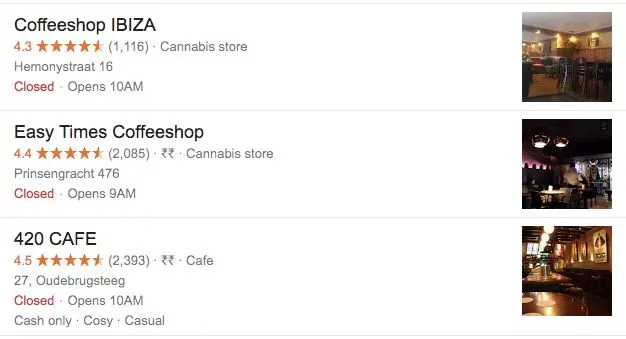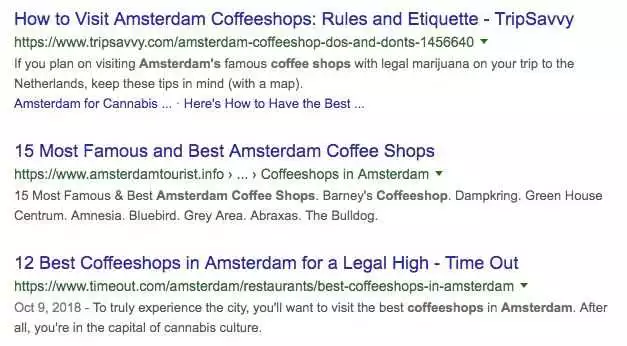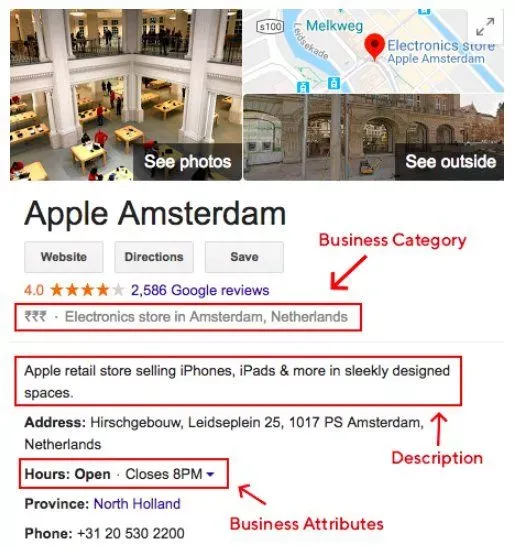If you are a local business, you already know that people are turning to Google to search for what you offer and you definitely want to be found there regardless of whether you are a local bagel shop or a chain of pizza restaurants!
And when we talk about being found in local search, there are two places that we mean! A top spot in:
- Map listings

- Organic listings

According to Search Engine Watch, a top map listing on Google receives 33% of the traffic, and the organic listings receive 40% of the clicks, taking home the gold.
That said, how do you rank your business higher on Google in all aspects to gain more traffic?
You can be easily found in top Google search results by getting your local SEO on point. However, before getting started with improving your ranking on Google, let us have a proper understanding of factors that contribute to where exactly you are going to be found on Google searches.
How Google determines local ranking
Local search results are primarily based on three factors - Proximity, Relevance, and Prominence.
Proximity
It is the number one factor that Google takes into account when serving up the results. In simple words, proximity is how close is your business to the person who is searching for it? If a user fails to specify a location in their search, Google will calculate distance based on what's known about their location.
Relevance
Relevance alludes to how well a local listing matches what somebody is searching for. Including the detailed information of a business can help Google better comprehend your business and match your listing to relevant searches.
Prominence
It refers to how popular a business is. A few businesses are increasingly noticeable in the offline world, and search results try to mirror this in local ranking. For instance, famous salons or hotels that people are familiar to in the offline world are likely to be famous in local search results. The factor of prominence is also based on information like links, articles, and directories that Google has about a business from over the web. Your Google review count and score are likewise the components that are responsible for improving a business' local ranking.
Now that you have known the factors that Google consider while determining your business' local ranking, let us learn a few tricks that will help your local business rank higher on Google. You just need to follow these steps, and you will be good to go.
How to improve your local ranking on Google
If your business doesn't appear for relevant searches in your area, here are some tips you should consider following to rank your local business higher on Google.
- Optimize Google My Business listing
- Get more customer reviews
- On-site optimization
- Local link building
Click here to jump to downloadable infographic.
Optimize Google My Business listing
Google My Business is very favorable for local SEO, and the best part is that the service comes free of cost.
To increase your chances of showing up in local search results, claim and verify your GMB listing and take a few minutes every day for optimizing your Google My Business listing. Doing this will help your business appear in Search and Maps even more frequently.
1. Enter complete business information
Businesses with accurate and comprehensive information are most likely to rank higher in Google searches. Therefore, ensure you fill out all of your business information in Google My Business, so customers find out about what services you offer, what time they can visit you, and where they can find you. Provide information like your phone number, address, name, aand ensure to keep this information updated as your business changes.
2. Verify your business location(s)
Creating and verifying location information gives your business an excellent opportunity to appear for users across Google maps and searches when local searches occur on Google.
3. Keep your hours of operation accurate
Adding and updating your hours of operation, including special hours for holidays and special events in your GMB listing is significant for your business' presence. You should keep your business hours as accurate as possible as it lets potential customers know when you're accessible and gives them confidence that when they visit your location, it will be open.

4. Include keywords in your description
Whenever possible, use the most relevant keywords in your Google My Business description, however, use them naturally—don't force them in as you would not want your Google My Business account get permanently suspended due to this penalty-inducing offenses
5. Manage customer reviews and respond to them
Responding to online customer reviews is a great way to show that the business values its customers and their opinion/feedback about the product. Positive reviews by customers will enable potential customers to form a good viewpoint on the business they are researching. Positive or helpful reviews can also increase the visibility of your business in the organic and paid search results. To encourage your customers to give reviews or feedback, you should create a link where they can click and write their reviews or feedback.
Use Statusbrew to manage and reply promptly to thousands of reviews on your Google My Business page. Just head on to https://statusbrew.com/ and select the plan of your choice to start a 14-day trial
Suggested Read: How To Manage Google Reviews For Multiple Locations
6. Upload photos
No GMB listing is complete without pictures! According to Google, businesses with photos on their listings received 42% more direction requests to their business, and 35% received more visitors in their websites in comparison to businesses that don't add photos. That said, ensure adding accurate, appealing, and high-quality photos of your office, employees, and products to your listings. Doing this will not only allow your customers to take a 360-view virtual tour of your business but will also let you tell the story of your business! Keep in mind,
The more the users envision your business online, the more will they be interested in it
Still confused over how to optimize Google My Business listing for improved local ranking, check out this complete guide.
Get more customer reviews
It is essential to have reviews on your Yelp or Google My Business Page. So for that, ask customers to leave reviews of your business as well as rate your company since it builds a sense of credibility in the eyes of the audience. If you are a local coffee shop, you can request your happy customers to write reviews and their experiences about your cafe.
Likewise, ensure that you are responding to the reviews in time. Particularly in case of the restaurants or cafes, the reviews come in large numbers. Therefore, it becomes crucial to respond to those reviews regardless of whether they are positive or negative — guarantee formulating a professional and well-thought-out response to the reviews.
Related: You might also want to read this guide on Outsmart Fake Negative Reviews On Google My Business & How To Spot A Fake Review? 5 Tips And Tricks.
On-site optimization
-
Target the right keywords: Just like you incorporate keywords in your Google My Business description, consider including the right keywords on your website as well -- your audience reaches you through these keywords. To research relevant keywords, you can use keyword research tools like Google Keyword Planner and Semrush. Then, come up with list of keywords which have a high search volume and low competition.
Note: You want to identify keywords for your local SEO that pertain to your geographic location. Consider the various locations and areas you service and where your customers are from.
For instance, the chemist may target keywords like:
- Best chemist in Durham.
- Chemist near Hillsboro road, Durham.
-
Meta title and description: The first information that your customers view on search results is your Meta Title and Description. Ensure these elements are well optimized and include your target keyword within 65-70 characters of meta title and 155-160 characters of the meta description.
-
Heading tags: To get an idea about the content of the page, Google bots look for keywords within the header (H1,H2) tags. Incorporate the most important keywords in H1, then H2 and so on. For instance:
- h1-Rosies Diner Cafe
- h2-Book a table right now
- h2-Menu
- h3-Special offers
-
Content: Keep in mind, on-site SEO is less about keyword repetition or placement and more about understanding who your customers are, what they're searching for, and about what topics (keywords) can you as a business owner create content that best fulfills that need.
-
If you are a chain of business, make sure you have unique and relevant content for each of your business location.
-
Include high-quality photos of your office, employees, and products. For instances, if you're a salon, you can add pictures of some of your outstanding services.
-
Embed a Google Map on your website, so that it is easier for your customers to locate you.
-
Ensure you include complete NAP + other details (like working hours, email-id, discount offers, promotions, customer testimonials, and so on) across your website.
Note: Every information you share about your business is consistently shared on your website, social media, Google My Business, or anywhere online. Listing accuracy is Google's method for deciding whether or not it can trust a local business search result, and if you are not taking it seriously, it is the biggest mistake that you are committing.
Local link building
Just like link building in general, local link building is also considered as the building blocks for good SEO. However, unlike link building in general, local link building is not about obtaining links from high authority websites but acquiring links from local websites doing something similar to you.
Getting listed in local directories is the best way to get started with local SEO.
Here are some other ideas:
- Local meetups are an untapped goldmine. Find local groups looking for a location for their meeting, offer up your place of business, and BOOM! You've got a secure local link
- Hosting an event open to the community is a simple way to get links and social mentions
- Find local bloggers and start to network, it won't be hard to get them to write about your business and include a link
- Get yourself nominated for local awards. The winners typically get links as the results are nearly always published online
- Arrange for interviews with quality online publications
Infographic
Here's a detailed infographic on how to rank your local business higher on Google.

Citation Policy: Please feel free to use the infographics in this blog in any commercial or non-commercial capacity. If you use the infographics, we require a reference back to Statusbrew Blog.
Over to you!
These tips for improving rank of your local business on Google would put you ahead of your competitors and would help you rank high on Google search and maps. Put these advices to use, and you should expect to see some improvement in your Google rankings and in your store.
What different strategies do you use for Local SEO? Let us know in the comments below.




Explore the Statusbrew range of social media tools
Cancel anytime!